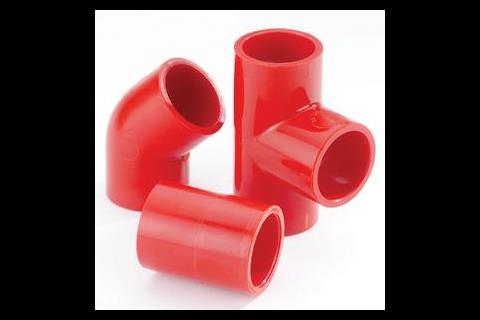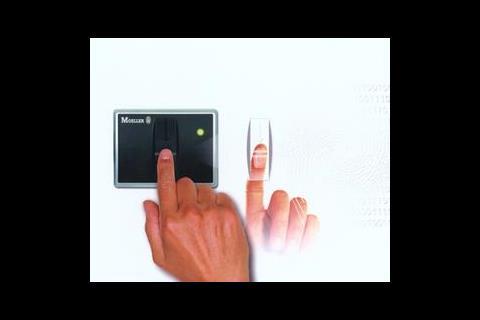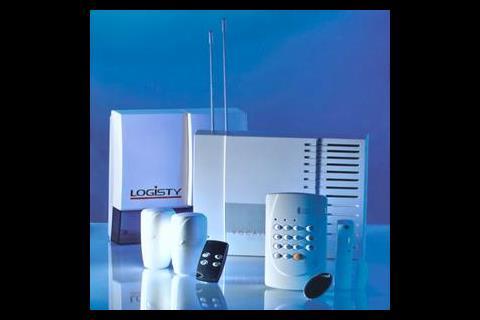From this month, we will be taking a look at specialised product developments in every issue. This time, it’s new launches relating to fire and security design
Clarion call
Clarion Communications has introduced Lifeline, a wireless fire detection and alarm system for the disabled and hearing impaired.
The system is designed to comply with BS5839-1: 2002. When the main building fire alarm is activated, the fail-safe relay contacts alert the Pacscom transmitter to the alarm status and in turn, it either alerts the CSP receivers, which provide alpha/ numeric serial text data output to displays, or the vibrating pager(s). The system simply sends out pre-defined alarm messages to the vibrating pager, wall- mounted display or both upon activation of the fire alarm and continues to alert the vibrating pager or display until the main fire panel is reset.
More information 170
Pipe dream
Durapipe UK has introduced Detecta-line, a pipework system specifically designed for use with aspirating smoke detection systems. This type of system can detect smoke at vastly lower densities than ordinary smoke detection systems. However, the satisfactory operation of these systems is reliant upon the capabilities of the associated pipework. Produced from robust and ductile ABS material, Detecta-line is a solvent welded system and sampling holes can simply be drilled into the pipework to allow active air sampling throughout the system.
More information 171
Fingertip control
Lost ID cards and forgotten passwords could be a thing of the past with the launch of Moeller Electric’s M22-ESA fingerprint reader. The unit is designed for applications such as access control to buildings and can store data for up to 100 users – all they need to do is drag their finger slowly over the sensor which generates a unique code based on the temperature differences between the ridges and grooves of their fingerprint pattern.
The unit’s facia measures just 65 mm x 50 mm x 16 mm, and has a back of panel control section, which is little larger.
More information 172
Detection and alarm
Klaxon Signals has launched the Sonos Universal base sounder. The low-profile unit is designed for fixing beneath a variety of smoke and heat detectors in existing fire alarm systems and enables detection and alarm at the same point, eliminating the need for separate sounders in the circuit, and ultimately reducing wiring costs. The Base Sounder has an output of 95 dB and 32 distinct alarm tones.
More information 173
keep the vandals out
BPT Security Systems has added to its range of digital door entry panels with a stainless steel vandal-resistant version.
Manufactured from 2.5 mm thick stainless steel, it is designed to work with the company’s 200 and 300 door entry systems. The new panel has the ability to display up to eight pre-programmed scrolling screen messages or information text.
More information 174
Quick fix
Logisty has introduced Vocalis, a wireless burglar alarm which it claims is up to five times faster to install than a comparable wired system. The control panel siren receives information from detectors and controls and triggers alerts and deterrents, including sirens, strobes and/or telephone diallers.
The system identifies up to 15 zones with interior motion detectors and door and window contact detectors.
n ÿMore information 175
If your face fits…
Premier Electronics has launched the A4 Secure Site facial recognition system which offers fast, high security biometric access control.
The system combines 3D facial recognition technology with the scalability and features of an access system. It can be managed as a two or four-door system, or scaled up to hundreds of doors and users.
More information 176
Camera, action…
Siemens has introduced a new range of dome cameras to enhance its cctv product range. The range includes high resolution colour, low-light colour and day/night models. Among the features offered by these units are programmable tours, preset titles and privacy zones.
The cameras can be surface or in-ceiling mounted, suspended or mounted externally with the aid of a range of bracket options.
More information 177
Code of practice for sprinklers
British Standards has published a new code of practice covering sprinkler system maintenance.
What is it called? BS 9251:2005 Sprinkler systems for residential or domestic occupancies. It replaces DD251: 2000
What does it do? This British Standard gives recommendations for the design, installation, components, water supplies and backflow protection, commissioning, maintenance and testing of fire sprinkler systems installed for life safety purposes – with additional benefits for property protection in residential and domestic occupancies.
What is covered? Residential occupancies, for multiple occupation, not exceeding 20 m in height, including apartments, residential homes, houses of multiple occupancy, blocks
of flats, boarding houses, old people’s homes, nursing homes, residential rehabilitation accommodation and dormitories. Domestic premises include individual houses, flats, maisonettes and transportable homes.
How do I get a copy? Call 020 8996 9001
or email orders@bsi-global.com
Practical tips for Specifying fire detection systems
The next time you choose a fire detection system, there are a number of points worth bearing in mind. Andrew Morgan from Siemens Building Technologies provides some tips:
Conduct a risk assessment to ascertain what needs to be protected from a fire. The approach required to protect people may be different to that needed to protect property.
BS 5839 Part 1: 2002 identifies five possible system coverage options for life safety. Ensure you receive competent advice before choosing what is right for your premises.
False alarms are a huge problem and can cost businesses a vast amount of money as a result of interruption. Consider carefully both the technology and layout of the system to prevent or reduce their frequency.
If it is important to know exactly which detector has gone into alarm, consider an addressable fire detection system. This will help reduce search times and help with the management of any false alarms.
All detectors sold in the EU will comply with a European norm where it exists. A third party approval body such as LPC, FM or UL etc can often verify the performance of the device.
Fire alarm companies and their levels of experience and expertise vary widely. The
Chief Fire Officer’s Association recommends that companies certificated under a recognised scheme, such as LPS 1014 or SP 203, should be given priority when installing systems for connection to an alarm receiving centre.
Ensure that the potential costs of maintenance are designed into the system by using technology that avoids costly access issues wherever possible .
Monitor the installation to ensure detectors are positioned in accordance with BS 5839 Part 1 2002. Special cable is required and later repositioning can be expensive.
Source
Building Sustainable Design
Postscript
How do I get a copy? Call 020 8996 9001 or email orders@bsi-global.com


























No comments yet